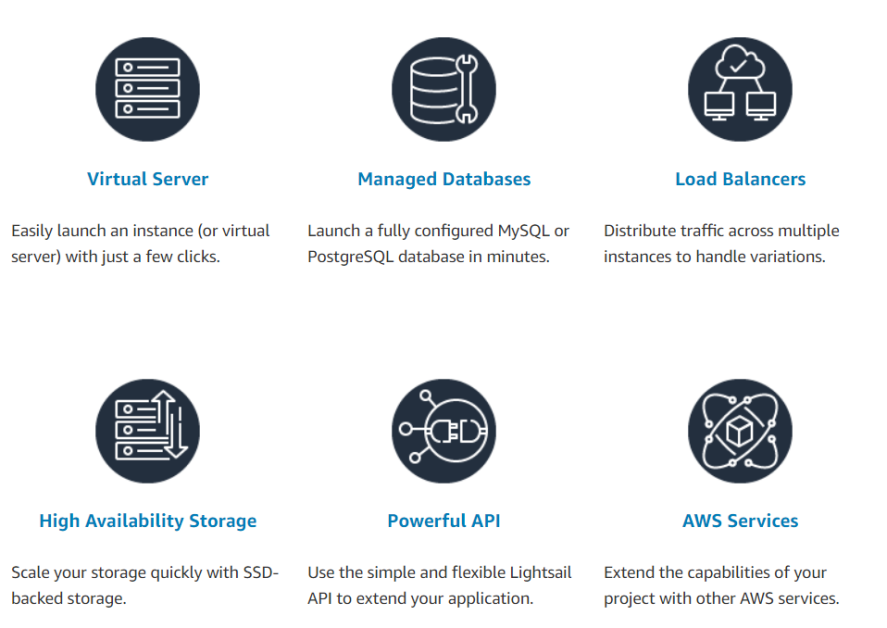AWS Lightsail is a beginner-level service for hosting small-scale web applications. In this article, we will cover everything you need to know about AWS LightSail.
AWS is a cloud computing giant. It is the biggest and the most used cloud provider in the world that has over 200 services. If you are familiar with AWS, you must have heard of the AWS Service Elastic Cloud Compute or EC2. EC2 is one of the oldest services from AWS, launched in 2006.
Using the AWS EC2 service, you can create Virtual Private Servers that can be used for any use case—for example, hosting a web application or data processing app. Although EC2 is cost-effective and fairly simple to use, it has a lot of features and parameters which can be overwhelming for beginners. This is why AWS launched its newer service to provision Virtual Private Servers, AWS LightSail, in late 2016.
AWS LightSail encapsulates a lot of over-complicated features of EC2 and simplifies the whole infrastructure provisioning and application deployment. So, if your requirement is to simply host a WordPress web app or a custom web app without too much hassle, LightSail is your best choice. Let us have a look at its features to have a better understanding of LightSail.
AWS LightSail Features

Fast & Easy
AWS LightSail is designed to be the easiest service for provisioning Virtual private servers. It allows you to create VPS in a few clicks by simply selecting pre-configured templates for your requirements like WordPress, Magneto, LAMP, and many more. AWS LightSail also configures security and networking capabilities automatically, making the whole process easier.
Cost and efficiency
AWS LightSail is cheaper and a better choice than EC2 instances for small applications. Even the most affordable Lightsail pricing plans include everything you need to jumpstart your project like a virtual machine, SSD, data transfer capabilities, DNS management, and a static IP address. Using LightSail is free for 3-months, and after that, it can be as cheap as 3.5$ per month.
AWS Cloud
AWS LightSail is built on the world’s leading cloud, AWS. This allows you to easily integrate your LightSail applications with many other services in AWS like RDS databases, AWS Lambda, SQS queues, and much more. The possible combinations of integrations and applications are limitless.
Simplified load balancers
AWS Lightsail’s simplified load balancing routes web traffic across your virtual private servers to accommodate variations in traffic and provide a seamless user experience.
Databases
This is a lesser-known feature of LightSail. Apart from providing servers to host your applications, it also offers fully configured MySQL or PostgreSQL database plans.
Storage
LightSail offers seamless integration with SSD-backed block storage devices for Linux and Windows machines. For object storage requirements, you can always connect your application to S3 buckets in your account.
Upgrading to EC2
As you get more familiar with AWS, you might want to migrate your LightSail application to EC2. LightSail provides a guided procedure to migrate LightSail apps to EC2 instances. To migrate your application to EC2 first, you have to take a snapshot of your instance and export this snapshot from the LightSail console to the EC2 console. AWS has a great article that can help you with this upgrade. Once your snapshot is exported, you can use the “Upgrade to EC2” wizard to start your LightSail application on EC2.
Difference between AWS LightSail and EC2

Both AWS LightSail and EC2 are services for provisioning Virtual Private Servers. To best understand AWS LightSail, you should know the difference between LightSail and EC2. This should help you make an informed decision between the two when the occasion arises.
| AWS LightSail | AWS EC2 |
| Used for simple web applications. | Used for enterprise applications |
| Has pre-configured templates for websites. | EC2 instances have to be configured manually. |
| Applications are limited to one server. | Applications can span any number of servers. |
| No discount models. | Offers multiple pricing models and discounts. |
| Is an all-in-one service, offering load balancers and databases | Only offers Virtual Private Servers. (can be manually configured as Load Balancers or Databases) |
| Less control over instance configuration. | Offers complete control to configure VPS(s) for all requirements. |
| Networking and security are configured automatically. | Networking and security have to be configured by the user. |
| Only offers instances meant for light workloads. | Offers instance types that are optimized for specific workloads. |
Both, LightSail and EC2 are highly powerful, and mature services are meant for completely different use cases. EC2 instances are highly configurable and can be used for all kinds of use cases. EC2 also has different Instance families, each optimized for specific workloads.
The list of EC2 features is endless, which also means that EC2 is a complicated service. LightSail, on the other hand, is intended for small-scale applications and workloads. You do not have a lot of control over instance configuration. However, you can use LightSail to jumpstart your applications even as a beginner in AWS.
Conclusion
AWS LightSail is an excellent choice to host development and test environments or small-scale production environments. It is a simple and easy service that will allow you to start your application for an extremely low price.
You may also look at some of the lesser-known AWS offerings.



